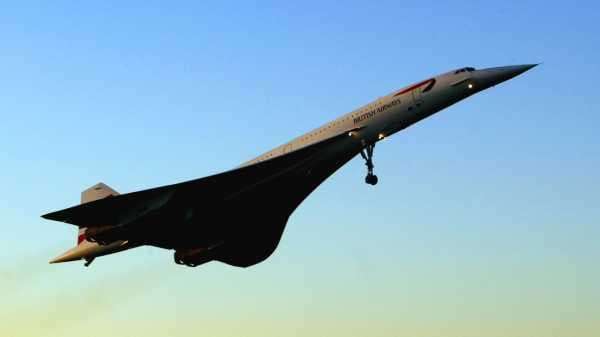
The progress of technology can seem inexorable—a kind of unstoppable lunge. It’s curious, then, to consider the trajectory of Concorde, the first (and last) supersonic passenger airplane. Americans often refer to “the Concorde,” as if it were a single aircraft, but twenty were built, and fourteen flew commercially between 1976 and 2003. Concorde shuttled moneyed fliers from New York to London in three and a half hours or less, travelling at Mach 2, or twice the speed of sound. The aircraft generated a foul puff of smoke and a sonic boom on takeoff, but, onboard, life was crisp and elegant: champagne flutes, canapés, wine pre-selected from a cellar. It has been said there were fresh-cut flowers in the lavatory.
“Supersonic: The Design and Lifestyle of Concorde,” a new book by the graphic designer Lawrence Azerrad, is an encomium to Concorde as a design object. I can only imagine the giddiness that Concorde’s earliest passengers must have felt, wiping their lips with a cloth napkin, sampling caviar, winding their wristwatches to Continental time. The journey was not merely to be endured but to be relished. Concorde flew so high that the curve of the Earth was visible from the window. How close the future must have felt.
In 1947, Chuck Yeager became the first pilot to break the sound barrier, flying a rocket-powered Bell X-1 over the Mojave Desert. In “The Right Stuff,” Tom Wolfe’s book about Yeager and his cohort, Wolfe describes what Yeager saw from forty thousand feet: “The sky turned a deep purple and all at once the stars and moon came out—and the sun shone at the same time. He had reached a layer of the upper atmosphere where the air was too thin to contain reflecting dust particles.”
Soon after, several nations, including the U.S., began working in earnest to adapt the technology to commercial travel. They were driven by a mix of mid-century futurism and the same postwar competitiveness that fuelled the space race. France and Britain, in partnership, succeeded first, completing two supersonic prototypes, both of which flew successfully, in 1969. (Boeing, under a mandate from President Kennedy, had begun developing the Boeing 2707, which was designed to fly at Mach 2.7, but funding was cut before an aircraft was completed.)
We had supersonic air travel, and then we didn’t, and the reasons are fairly banal. One factor was a high-profile crash that happened in France, in 2000, when a chartered Concorde hit a piece of debris left on the runway, puncturing a tire and a fuel tank. A hundred and thirteen people were killed. But, ultimately, Concorde’s normal operations just became economically untenable. It was too loud and disruptive to fly over residential land, and fuel requirements limited the scope and affordability of its route. When travel spending dipped after 9/11, Concorde became financially beleaguered. The last operating plane was retired in 2003. (By then, it cost around twelve thousand dollars for a round-trip ticket.)
In the foreword to “Supersonic,” the designer Terence Conran calls Concorde “the most beautiful and exhilarating man-made object I have ever seen.” It remains easy to fetishize, in part because we lost it, and in part because it was so plainly handsome. The aircraft’s iconic design—the needle-shaped fuselage, the so-called droop snoot, which bent on takeoff and landing to allow pilots to see out the front window, those sweeping delta wings, painted a gleaming white—was chiefly functional, but it read as polished and opulent.
Inside, the aisle was only sixteen inches wide, and the overhead storage bins didn’t accommodate much more than a briefcase or a hatbox. But the experience of flying Concorde was ritualized and romantic. Besides an elaborate meal, parting gifts (matchbooks, luggage tags, engraved flasks, letter openers, pillboxes, candlesnuffers, cufflinks, playing cards) were bestowed on passengers as they deplaned, and appreciative travellers were not above covertly swiping a souvenir. (Andy Warhol supposedly pocketed a set of stainless-steel flatware designed by Raymond Loewy each time he flew; as evidenced by eBay, others pilfered crystal drinking glasses, cocktail stirrers, menus, napkin rings, and more.) Azerrad is a collector of Concorde-related relics; in the book’s introduction, he admits to having gathered around seven hundred curios, many of which are photographed and presented in “Supersonic.” Concorde inadvertently “pioneered what was to become the art of branding,” he writes. Each item feels sleek, aspirational.
“Supersonic” is also an inadvertent lament about the way that we travel now. Aviation itself is a miracle: every day, thousands of people board airplanes on one continent and safely disembark on another, and that alone is awesome. But commercial air travel is often a demoralizing affair. There are the mundane indignities—attempting to drag a wheeled suitcase with a stupid ribbon tied to the handle down a too-narrow aisle, or having to rouse a stranger from a deep slumber because there is no other way to access the restroom from your middle seat, or shouting into your telephone because you have missed yet another connection due to compounding delays. And sometimes the experience becomes truly hellish. In 2017, a man was dragged down the aisle of an overbooked United flight, bloodied and humiliated after refusing to give up a seat that he’d reserved and paid for in advance; this year, on another United flight, a woman was forced to place her ten-month-old French bulldog in an overhead bin (the dog suffocated).
Concorde was unaffordable for most people, and its fuel needs were disastrous for the environment. Yet, like anything built on idealism, it was also thrilling—it suggested a frictionless, more accessible world. “Concorde was the promise of tomorrow delivered in the here and now,” Azerrad writes. At the time, it surely felt as though everything about the way we conceived of and traversed the globe had changed. Although it feels preposterous to consider now, the fate of Concorde should also remind us that the nonrenewable resources that allow for things like smartphones and laptops could eventually become so expensive or destructive that we will be forced once again to regress—to drag our rotary-dial desk phones out of attics and basements and re-adjust to a slower way of life.
Sourse: newyorker.com






